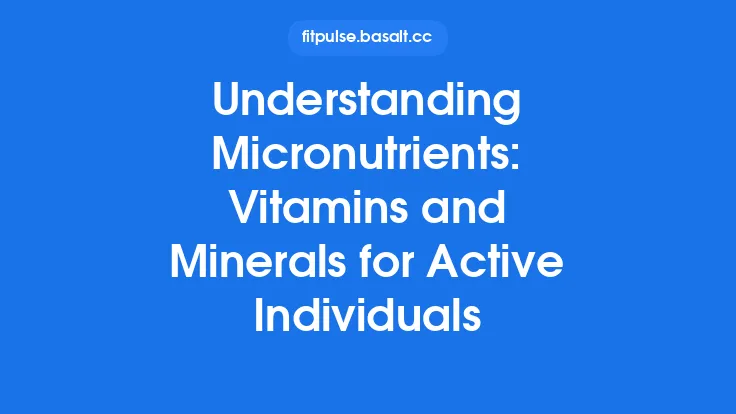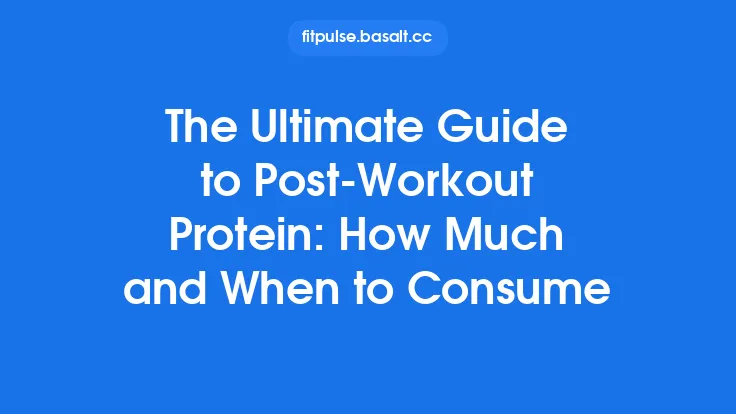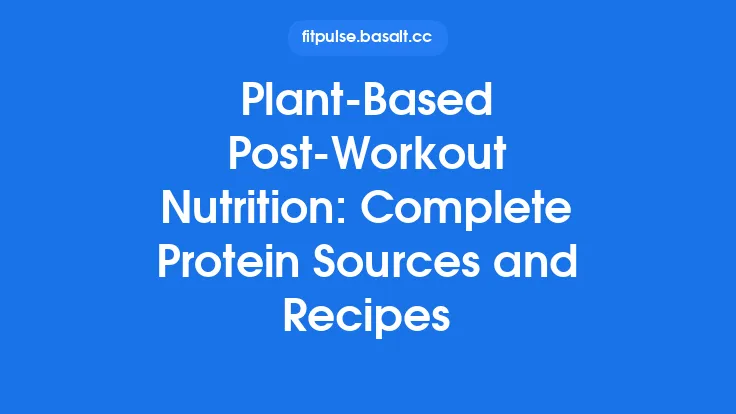Plant‑based nutrition has moved from the fringe to the mainstream of athletic performance, driven by advances in food technology, growing research, and a cultural shift toward sustainable eating. For athletes, the promise of a diet rich in fruits, vegetables, legumes, nuts, and whole grains is compelling: lower inflammation, faster recovery, and a reduced risk of chronic disease. Yet the transition also raises legitimate concerns about meeting the heightened protein and micronutrient demands of rigorous training. This article unpacks the science behind plant‑based diets for athletes, outlines practical strategies to hit protein targets, and highlights the micronutrients that require special attention. By the end, you’ll have a roadmap for building a nutritionally complete, performance‑optimizing plant‑based regimen—whether you’re a marathoner, a powerlifter, or somewhere in between.
Understanding Protein Requirements for Plant‑Based Athletes
Athletes generally need more protein than sedentary individuals to support muscle protein synthesis (MPS), repair tissue damage, and adapt to training stress. Consensus guidelines suggest 1.4–2.0 g protein kg⁻¹ body weight per day for most endurance and strength athletes, with the upper end reserved for those in heavy resistance training or high‑volume endurance phases.
For a 70 kg (154 lb) athlete, this translates to 98–140 g of protein daily. The challenge for plant‑based eaters is not the total amount but the distribution of essential amino acids (EAAs) and the digestibility of plant proteins. Unlike animal proteins, many plant sources are lower in one or more EAAs—most notably lysine in cereals and methionine in legumes. Consequently, athletes must be intentional about protein source selection and meal timing to ensure a steady supply of all EAAs throughout the day.
Evaluating Protein Quality: Complementary Proteins and Digestibility
1. Digestible Indispensable Amino Acid Score (DIAAS)
The DIAAS is the current gold standard for assessing protein quality, accounting for both amino acid composition and ileal digestibility. Animal proteins typically score >100, whereas most single plant proteins fall between 40–70. However, when complementary plant proteins are combined, the composite DIAAS can approach that of animal sources.
2. Classic Complementary Pairings
- Cereals + Legumes: Wheat, rice, or corn paired with beans, lentils, or peas provide a balanced profile of lysine (from legumes) and methionine (from cereals).
- Nuts/Seeds + Legumes: Almonds, pumpkin seeds, or hemp seeds combined with soy or chickpeas boost both lysine and sulfur‑containing amino acids.
3. High‑Quality Plant Proteins
Some plant foods naturally have a more complete amino acid profile:
- Soy (tofu, tempeh, edamame): DIAAS ≈ 84–100, comparable to dairy.
- Quinoa: Complete protein with a DIAAS around 78.
- Buckwheat: Offers a balanced EAA profile.
- Hemp seed protein: Rich in arginine and omega‑3 precursors, with a DIAAS near 70.
4. Protein Powders and Isolates
Pea, rice, soy, and mixed plant protein isolates can bridge gaps, delivering 20–30 g of protein per scoop with high digestibility. When selecting a powder, look for products that have undergone enzymatic hydrolysis or fermentation to improve absorption.
Strategies to Achieve Adequate Protein Intake
- Distribute Protein Evenly Across Meals
Aim for 20–30 g of high‑quality protein every 3–4 hours. This pattern maximizes MPS and prevents long periods of low amino acid availability.
- Incorporate Protein‑Rich Snacks
- Roasted chickpeas (15 g protein per cup)
- Greek‑style soy yogurt (10 g protein per 150 g)
- Protein bars based on pea‑rice blends (20 g per bar)
- Leverage Fortified Foods
Many plant milks, cereals, and breads are fortified with added protein (e.g., soy‑protein fortified oat milk).
- Use Whole‑Food Blends
A bowl of quinoa, black beans, roasted vegetables, and a drizzle of tahini can deliver 25–30 g of protein while providing fiber, micronutrients, and healthy fats.
- Plan for Post‑Workout Recovery
Within 30–60 minutes after training, consume a rapid‑digesting protein source (e.g., a pea‑protein shake) combined with carbohydrates to replenish glycogen and stimulate MPS.
Micronutrient Challenges in Plant‑Based Sports Nutrition
While a well‑planned plant‑based diet can meet macronutrient needs, certain micronutrients are less abundant or less bioavailable in plant foods. Athletes, who experience higher turnover of vitamins and minerals due to sweat loss, oxidative stress, and tissue repair, must pay special attention to these nutrients.
Iron: Heme vs. Non‑Heme Considerations
Why It Matters: Iron is essential for oxygen transport (hemoglobin) and cellular energy production (myoglobin, mitochondrial enzymes). Iron deficiency can impair endurance performance and cause fatigue.
Plant Sources: Lentils, chickpeas, tofu, pumpkin seeds, fortified cereals, and dark leafy greens. Non‑heme iron has lower absorption (≈2–20 %) compared to heme iron from animal sources.
Enhancing Absorption:
- Vitamin C Pairing: Consuming citrus juice, strawberries, or bell peppers with iron‑rich meals can increase absorption by up to 3‑fold.
- Avoid Inhibitors: Polyphenols (tea, coffee), phytates (raw beans, whole grains), and calcium can reduce iron uptake. Timing these foods away from iron‑rich meals helps.
Monitoring: Athletes should have serum ferritin checked at least twice a year. If ferritin falls below 30 ng/mL, dietary adjustments or supplementation may be warranted.
Calcium, Vitamin D, and Bone Health
Calcium Sources: Fortified plant milks, tofu set with calcium sulfate, almonds, sesame seeds (tahini), and leafy greens (kale, bok choy).
Vitamin D: Sun exposure remains the primary source, but athletes training indoors or at high latitudes often need supplementation (800–2000 IU/day) to maintain serum 25‑OH‑D levels >30 ng/mL.
Synergy: Adequate vitamin D enhances calcium absorption and supports bone remodeling—critical for athletes subjected to high impact or weight‑bearing activities.
Vitamin B12: The Critical Nutrient for Vegans
Vitamin B12 is virtually absent from unfortified plant foods. Deficiency can lead to anemia, neurological impairment, and reduced energy metabolism.
Sources for Athletes:
- Fortified Nutritional Yeast (≈2.4 µg per tablespoon)
- B12‑fortified plant milks and cereals
- Methylcobalamin or cyanocobalamin supplements (25–100 µg daily)
Regular testing of serum B12 and homocysteine is advisable, especially during periods of intensified training.
Zinc, Iodine, and Other Trace Elements
- Zinc: Important for immune function, protein synthesis, and testosterone production. Plant sources include pumpkin seeds, lentils, chickpeas, and fortified cereals. Phytates can inhibit zinc absorption; soaking, sprouting, or fermenting grains and legumes can mitigate this effect.
- Iodine: Crucial for thyroid hormone production, influencing metabolism and recovery. Seaweed (nori, kelp) provides a potent source, but intake should be moderated to avoid excess. Iodized salt is a reliable, low‑risk option.
- Selenium: Found in Brazil nuts (one nut can meet daily needs). Selenium supports antioxidant enzymes that protect muscle cells from oxidative damage.
Omega‑3 Fatty Acids from Plant Sources
EPA and DHA, the long‑chain omega‑3s, are linked to reduced inflammation and improved cardiovascular function. While algae‑derived supplements provide direct EPA/DHA, plant foods supply ALA (alpha‑linolenic acid), which the body converts at a low rate (≈5 % to EPA, <0.5 % to DHA).
Key Sources:
- Flaxseed (ground) – 2.4 g ALA per tablespoon
- Chia seeds – 1.6 g ALA per tablespoon
- Hemp seeds – 0.6 g ALA per tablespoon
- Walnuts – 2.5 g ALA per ¼ cup
For athletes seeking optimal EPA/DHA levels, a daily algae‑based supplement (250–500 mg combined EPA/DHA) is a practical addition.
Practical Meal Planning and Sample Menus
Breakfast
- Smoothie Bowl: 1 cup fortified soy milk, ½ cup frozen berries, 1 scoop pea‑protein isolate (20 g protein), 1 tbsp ground flaxseed, 1 tbsp almond butter.
- Nutrient Highlights: 30 g protein, 500 mg calcium, 15 µg vitamin D (fortified), 10 µg B12 (fortified), 5 g ALA.
Mid‑Morning Snack
- Roasted Edamame: 1 cup (≈17 g protein), sprinkled with sea salt and lemon juice (vitamin C).
Lunch
- Quinoa‑Black Bean Power Bowl: 1 cup cooked quinoa, ½ cup black beans, ½ cup roasted sweet potato, ¼ cup sautéed kale, 2 tbsp tahini dressing, topped with pumpkin seeds.
- Nutrient Highlights: 25 g protein, 8 mg iron (enhanced by vitamin C from bell peppers), 300 mg calcium, 2 mg zinc.
Afternoon Snack
- Greek‑Style Soy Yogurt (150 g) + Berries + 1 tbsp chia seeds – ~15 g protein, 2 µg B12.
Pre‑Workout (30 min before)
- Rice‑Pea Protein Bar: 20 g protein, 30 g carbohydrate, 5 g fiber.
Post‑Workout
- Recovery Shake: 1 scoop soy‑protein isolate (25 g protein), 1 cup fortified oat milk, 1 banana, 1 tsp cocoa powder.
Dinner
- Tempeh Stir‑Fry: 150 g tempeh (≈20 g protein), mixed vegetables (broccoli, bell peppers, snap peas), 1 cup brown rice, soy‑ginger sauce. Served with a side of fortified miso soup.
- Nutrient Highlights: 30 g protein, 3 mg iron, 400 mg calcium, 2 µg B12 (fortified miso).
Evening Snack (optional)
- Almonds (¼ cup) + Dried Apricots – 6 g protein, 2 mg iron, 80 mg calcium.
This menu delivers ~150 g protein for a 70 kg athlete, meets calcium, iron, zinc, and B12 recommendations, and includes omega‑3 precursors and vitamin D.
Supplementation: When and What to Use
| Nutrient | Reason for Supplementation | Typical Dose for Athletes | Form |
|---|---|---|---|
| Vitamin B12 | Low in plant foods; prevents anemia & neuro issues | 25–100 µg daily (cyanocobalamin or methylcobalamin) | Tablet, sublingual, or fortified beverage |
| Vitamin D | Limited sun exposure; supports bone health & immunity | 800–2000 IU daily (adjust based on serum 25‑OH‑D) | Softgel or liquid |
| EPA/DHA (Algae) | Direct source of long‑chain omega‑3s; anti‑inflammatory | 250–500 mg combined EPA/DHA | Softgel or liquid |
| Iron (if deficient) | Low non‑heme absorption; supports endurance | 18 mg elemental iron daily (as ferrous bisglycinate) | Tablet; taken with vitamin C |
| Calcium (if intake <1000 mg) | Bone remodeling under training stress | 500–600 mg supplemental calcium (citrate) | Tablet or chewable |
| Zinc (if intake <8 mg) | Supports protein synthesis & immune function | 15–30 mg zinc picolinate (avoid >40 mg long‑term) | Tablet |
Supplements should complement, not replace, whole‑food sources. Periodic blood work helps tailor dosing and avoid excess (e.g., iron overload or hypervitaminosis D).
Monitoring and Adjusting the Diet
- Baseline Assessment – Record body weight, body composition, training load, and dietary intake for 3–5 days.
- Biomarker Testing – Every 6–12 months, check serum ferritin, hemoglobin, vitamin B12, 25‑OH‑D, calcium, and zinc.
- Performance Metrics – Track strength gains, VO₂max, recovery time, and perceived fatigue. Any decline may signal a nutritional gap.
- Iterative Tweaks – If protein intake falls short, add a serving of legumes or a protein shake. If iron is low, increase vitamin C pairing or consider a low‑dose iron supplement.
Using a nutrition tracking app that includes micronutrient data can simplify this process and provide visual feedback.
Frequently Asked Questions
Q: Can a plant‑based diet support elite strength athletes?
A: Yes. Studies on powerlifters and weightlifters following vegan diets report comparable gains in lean mass and strength when protein intake is ≥1.6 g kg⁻¹ day⁻¹ and micronutrient needs are met.
Q: Is it necessary to count every gram of protein?
A: While precise tracking helps during the adaptation phase, most athletes can meet targets by planning meals around protein‑dense foods (tofu, tempeh, legumes, fortified products) and using a protein shake post‑workout.
Q: Do plant proteins cause more gastrointestinal distress?
A: Some high‑fiber legumes can cause bloating. Soaking, sprouting, and cooking beans thoroughly reduces oligosaccharides that ferment in the gut. Gradually increasing fiber intake also allows the microbiome to adapt.
Q: How important is meal timing for plant‑based athletes?
A: Timing is secondary to total daily intake, but consuming 20–30 g of protein within the 2‑hour window after training maximizes MPS.
Q: Are fortified foods “cheating” the plant‑based philosophy?
A: Fortification is a practical tool to ensure nutrient adequacy, especially for B12, vitamin D, and calcium. It aligns with the broader goal of health and performance, not with a strict “unprocessed only” ideology.
By understanding the unique protein dynamics of plant foods, proactively addressing micronutrient gaps, and employing evidence‑based supplementation when needed, athletes can thrive on a plant‑based diet. The result is not just a sustainable eating pattern, but a performance platform that supports muscle growth, recovery, and long‑term health. Whether you’re just curious or fully committed to a vegan lifestyle, the strategies outlined here provide a solid foundation for meeting the rigorous nutritional demands of modern sport.





